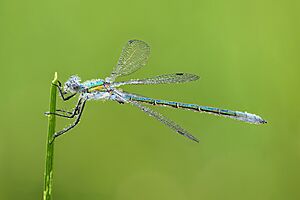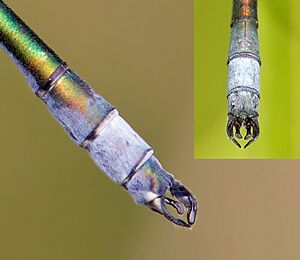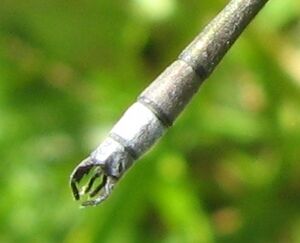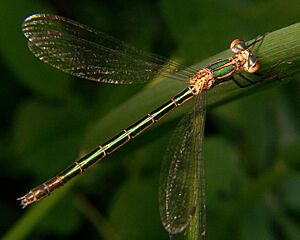Lestes dryas facts for kids
Quick facts for kids Lestes dryas |
|
|---|---|
 |
|
| Male (side view) | |
| Conservation status | |
| Scientific classification | |
| Genus: |
Lestes
|
| Species: |
dryas
|
The Emerald Spreadwing (Lestes dryas) is a type of damselfly. It belongs to the Lestidae family, also known as "spreadwings" because they often rest with their wings partly open. You might also hear it called the scarce emerald damselfly or robust spreadwing. In Ireland, it's sometimes known as the turlough spreadwing.
This damselfly lives across the northern parts of Europe, Asia, and North America. It can even be found in some areas of North Africa. The Emerald Spreadwing is quite tough! It can live in very difficult conditions that most other damselflies can't handle.
Contents
How to Spot an Emerald Spreadwing
These damselflies are usually about 35 to 42 millimeters long. Males are often a bit longer than females. A male's wings can spread about 45 millimeters wide, while a female's wingspan is around 47 millimeters.
Like other damselflies in the Lestes group, both male and female Emerald Spreadwings have bodies that are mostly metallic green. They shine with a bronze color, like a cool metallic paint job! When they rest, their wings are usually held half-open. The Emerald Spreadwing looks very much like another damselfly called the Emerald Damselfly (Lestes sponsa). It can be tricky to tell them apart!
Male Emerald Spreadwings
Male Emerald Spreadwings have bright blue eyes. As they get older, a powdery blue color appears on their bodies. You'll see this blue on the front and end of their abdomen (the long tail part), on their neck area (called the pronotum), and on the sides of their chest (thorax).
All Lestes damselflies look very similar. The best way to tell them apart is by looking closely at the shape and color of their "anal appendages." These are small parts at the very end of their abdomen. In L. dryas and L. sponsa, these parts are black. Other European Lestes damselflies have white or light-colored ones. The pictures below show the slight differences in shape between L. dryas and L. sponsa appendages.
Female Emerald Spreadwings
Female Emerald Spreadwings have a thicker abdomen than the males. They don't have any blue color on their bodies. Their eyes are usually brown to green. The underside of their bodies is a beige color.
Where Emerald Spreadwings Live
You can find the Emerald Spreadwing in a wide band across the world. This includes central Europe, Asia (from France all the way to the Pacific Ocean), and North America. It's the only Lestes damselfly found in both Europe and North America. If you're near the Mediterranean Sea, you'll find them in higher, mountainous areas.
They like quiet, shallow water with lots of plants. This includes places like ditches, ponds, bogs, and lakes. Sometimes, you can even find them near the coast in water that's a little bit salty. While they are found across Europe, they are not as common as the L. sponsa damselfly.
In Britain, people thought this damselfly had disappeared completely. But then, in 1983, it was found again! Since then, it has been seen in several places in southeast England. They mostly breed around the Thames Estuary and in a few lakes inland in Norfolk and Ireland.
Emerald Spreadwing Life Cycle
Adult Emerald Spreadwings fly from April in warmer southern areas to late May in northern regions. But you'll mostly see them flying in July and August. They tend to stay hidden in thick plants and rarely fly over open water. They prefer to stay close to the edges of ponds or lakes.
When it's time to mate, the male and female form a "wheel position." After mating, the male stays with the female to protect her while she lays her eggs.
The female lays long, thin eggs, usually on plant stems above the water. These plants, like rushes, will be covered by water when levels rise in winter. The eggs start to develop for a few weeks. Then, their development slows down a lot, and they enter a resting state called diapause. The eggs stay in this state through the winter.
In the spring, the eggs hatch into a very short-lived stage called a "prolarva." This tiny creature has no limbs and can't eat. But it can move by jumping or wiggling. If a prolarva hatches out of water, it will move around until it finds water. Once in the water, the prolarva quickly sheds its skin and becomes a "second stadia" larva.
These larvae are active hunters and grow very quickly. They shed their skin many times as they grow. In damselflies, the larval stage is the only time they grow bigger. If conditions are good, the last larval stage can be reached in as little as 8 weeks.
When the adult damselflies first emerge, they can't breed right away. They need a period of time to mature. It's during this time that the males develop their cool blue powdery color!
More About Damselflies
- List of damselflies of the world (Lestidae)
- List of Odonata species of Great Britain
- List of Odonata species of Metropolitan France






